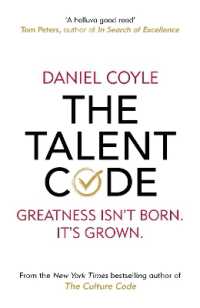基本説明
New in paperback. Hardcover was published in 2005. The first typology of co-compounds (for example, as when in some varieties of English 'mother-father' denotes 'parents') ever published, unites methods from typology, corpus linguistics, and ethnography of discourse.
Full Description
This book presents a typological survey and analysis of the co-compound construction. This understudied phenomenon is essentially a compound whose meaning is the result of coordinating the meanings of its components, as when in some varieties of English 'father-mother' denotes 'parents'. During the course of the book Dr Wälchi examines and discusses topics of great theoretical and linguistic interest. These include the notion of word, markedness, the syntax and semantics of coordination, grammaticalization, lexical semantics, the distinction between compounding and phrase formation, and the constructional meanings languages can deploy. The book makes many observations and points about typology and areal features and includes a wealth of unfamiliar data. It will be invaluable for typologists and of considerable interest to a variety of specialists including lexicologists, morphologists, construction grammarians, cognitive linguists, semanticists, field linguists, and syntacticians.
Contents
1. Introduction ; 2. The Marking Patterns of Natural Coordination ; 3. Tight Coordination ; 4. Co-compounds as a Lexical Class Type ; 5. A Semantic Classification of Co-compounds ; 6. The Areal Distribution of Co-compounds in the Languages of Eurasia ; 7. Some Considerations about the Diachronic Evolution of Co-compounds ; 8. Conclusions ; Appendix ; References ; Index of Persons ; Index of Languages ; Index of Subjects






